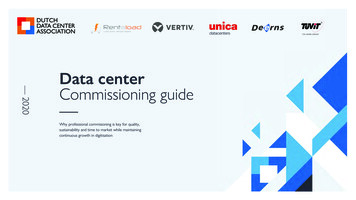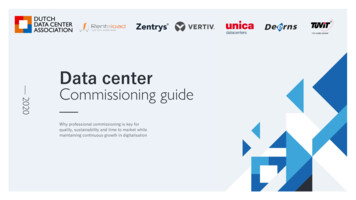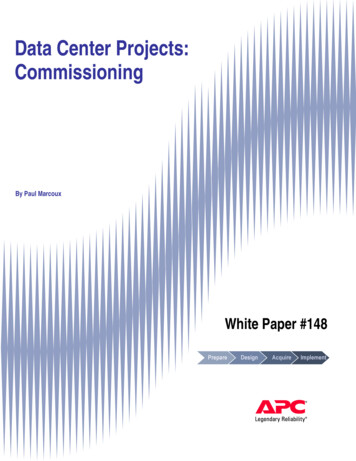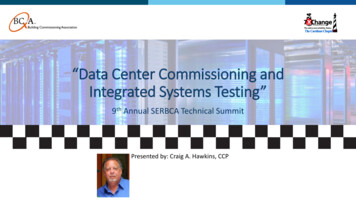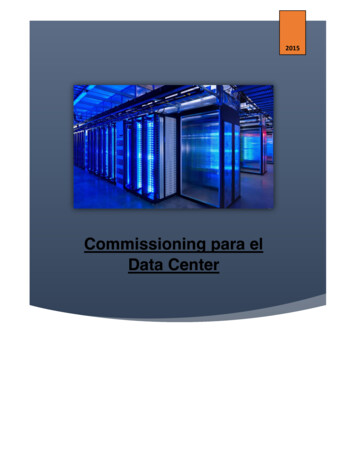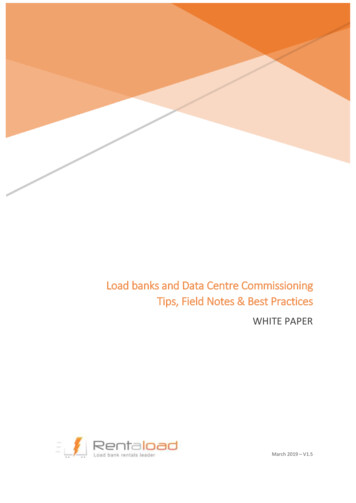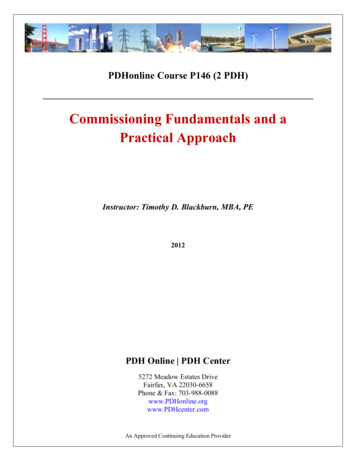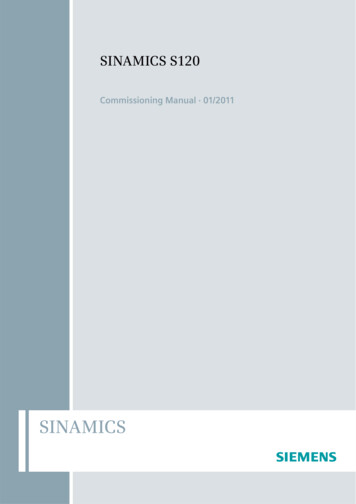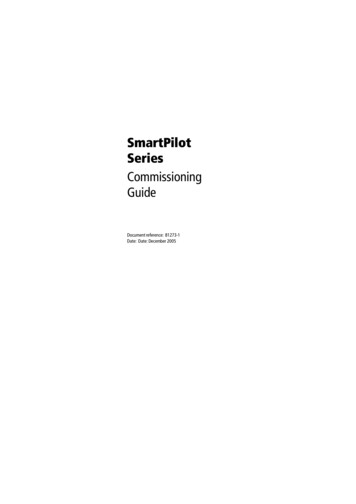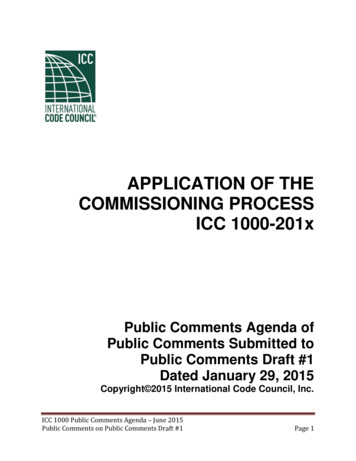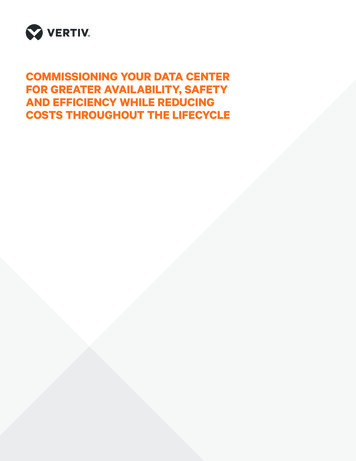
Transcription
COMMISSIONING YOUR DATA CENTERFOR GREATER AVAILABILITY, SAFETYAND EFFICIENCY WHILE REDUCINGCOSTS THROUGHOUT THE LIFECYCLE
TWO STAGE POWER DISTRIBUTIONExecutive SummaryCommissioning has existed as a discipline of the building construction industry for nearly three decades. Yet, the commissioningindustry is continually evolving and commissioning activities are still being defined by practitioners and industry organizations.Despite widely available standards, there is still considerable difference of opinion as to the definition of commissioning and theprocesses involved. As a result, commissioning is generally misunderstood and some of the most valuable commissioningprocesses are underutilized.In the data center world, commissioning is a relatively new concept. Data center owners have even less of a clear picture of thepurpose and value of this important process. Many owners lack an understanding of how, when, and why commissioning shouldbe implemented as a part of the design/build of a new system or process.The purpose of this white paper is to clearly define commissioning and its application in the data center environment. Data centerowners will gain perspective on the value the commissioning process can deliver and learn best practices for realizing thegreatest return on their commissioning investment.2
Defining CommissioningScope of CommissioningWhile the definition of commissioning varies greatly from onecommissioner to the next and one building owner to the next,industry experts, including Vertiv , generally concur thatcommissioning is an owner’s quality assurance program thatensures a new data center process, system, or addition meetsthe owners’ needs.One of the biggest challenges for owners investing in thecommissioning process is the lack of a consistent approachfrom commissioning firms. Some commissioners primarilyprovide administrative oversight, creating a pathway forpaperwork to flow. Other commissioners, including Vertiv,adopt a hands-on approach, fully engaging in activitiesranging from defining the owner’s needs in the pre-designphase, to conducting field tests and verifications, tooverseeing the warranty review post occupancy.Specifically, the American Society of Heating, Refrigeratingand Air-Conditioning Engineers (ASHRAE) asserts that thefocus of commissioning is “verifying and documenting thatthe facility and all of its systems and assemblies are planned,designed, installed, tested, operated, and maintained to meetthe needs of the owner.” The Building CommissioningAssociation (BCxA) adds that the basic purpose ofcommissioning is “to provide documented confirmation thatbuilding systems function in compliance with criteria setforth in the project documents to satisfy the owner’soperational needs.”In most cases, the term commissioning refers to newly builtprocesses and systems; however, existing systems can alsobe commissioned. Retro-commissioning can be performedto analyze and optimize the performance of systems thathave already been designed and built. Systems orassemblies that have been previously commissionedmay be re-commissioned to improve ongoing performanceand efficiency.Whether the system to be commissioned is new or existing,the objective of commissioning activities always ties back tomeeting the owners’ needs. As such, the owner is the bestperson to oversee the commissioning process. However,rarely does the owner have the time or expertise to fillthis role.Owners typically hire a commissioning authority (CxA), suchas Vertiv's Electrical Reliability Services, to provide buildingcommissioning services, and oversee and execute the entirecommissioning process. Unlike a commissioning agent, whohas legal authority to make decisions on behalf of the owner,the CxA does not have any decision-making power.However, a quality CxA will offer the expertise, guidance, anddirection the owner needs to make informed commissioningdecisions and realize the most value from the process.To further complicate matters, a general misconceptionexists that assumes commissioning and acceptance testingare one in the same. In fact, acceptance testing is a separatetesting requirement—often reviewed by the CxA—thatensures individual components or pieces of equipment areinstalled properly. It also ensures equipment will operateaccording to the manufacturer’s specifications and industrystandards. While certainly a critical step, acceptance testingis just one component of a much more comprehensivecommissioning process.In the same vein, commissioning has also been confusedwith equipment startup. Once again, a CxA often witnessesthe installation and startup of critical equipment and entiresystems; but like acceptance testing, startup is merelyanother individual construction activity that is oftenoverseen by commissioners.Because of these inconsistencies and misconceptions, it isnot uncommon for owners to request proposals from ahandful of different commissioners. They end up with a setof very different recommendations, accompanied by widelyvarying price points. It can be difficult to compare one bid tothe next. Nonetheless, hiring a knowledgeable commissionerwith a team-oriented approach can provide value that farexceeds the commissioning fee.3
TWO STAGE POWER DISTRIBUTIONThe Commissioning ProcessThe Argument for CommissioningIn the midst of these discrepancies, how then, can a datacenter owner determine the appropriate scope ofcommissioning activities for their project? To answerthis question, it is prudent to consider the reasons whymore and more data center owners are investingin commissioning.The major impetus behind commissioning data centersystems and processes is the increasing complexity of thesystems themselves. This complexity presents moreopportunities for problems. At the same time, there is lessand less tolerance for unplanned downtime. Due to thestaggering cost of unplanned outages or failures, today’s datacenters must operate reliably 100 percent of the time.Appropriate commissioning activities can ensure uptime byidentifying the culprits behind data center failures andoutages. Nearly 70 percent of early equipment failures can betraced to design, installation, or startup deficiencies.Unnecessary outages are often due to improper coordinationand calibration of protective devices, wiring errors, designerrors, and human error. Commissioning can help todetect and correct these problems before the failures oroutages occur.Frequently Commissioned Systems in Data CentersHistorically, commissioning was reserved for a building’selectrical and mechanical systems. Today, the entire buildingand all of its systems and processes can benefit fromcommissioning. While owners may choose to commissioneverything from security and fire/life safety systems tostructural systems and the building envelope, the mostfrequently commissioned systems in data centers include:yyElectrical distribution equipment and systemsyyMechanical and HVAC systemsyyMonitoring and controls systemsyySpecialty systems (EPO, security, VESDA,fire/life safety, etc.)yyLighting controlsyyStructural systemsPhases in the Commissioning ProcessCommissioning is also the answer to a wide variety of otherowner concerns such as ensuring the operations andmaintenance (O&M) staff have adequate resources andtraining; improving the safety of the data center; and boostingdata center efficiency. These concerns can all be addressedby specifying the right commissioning activities.It is helpful to think of commissioning as a process, ideallyfrom the planning phase or pre-design phase through oneyear of occupancy. From setting the project goals prior todesign, to accounting for warranty issues after turnover,the commissioning process can provide value throughoutthe project.The appropriate scope of commissioning, then, relatesdirectly to owners’ requirements for their data centers.Vertiv believes that a comprehensive approach tocommissioning—one that encompasses a wide range ofbuilding systems and spans the entire design/build process,from pre-design through occupancy—results in the greatestvalue to the project owners.The basic project timeline below shows the typical span of acomprehensive commissioning program.Contractor/Vendor StartupAcceptance TestingPRE-DESIGN/DESIGN PHASE4CONSTRUCTION PHASEIntegrated Systems Test1 Year PastTurn OverOPERATIONS PHASE
Depending on when the CxA becomes involved in theproject, commissioning activities generally occur inaccordance with the three major phases.Phase 1: Pre-Design/DesignDuring the pre-design or design phase of a project, the firstpriority of the CxA is to help determine and document theowner’s project requirements (OPR). The OPR becomes thekeystone of the commissioning project, and the CxA willmake sure that all commissioning activities align withmeeting these requirements.Based on the OPR, the CxA will develop the writtencommissioning plan. The plan will identify systems to becommissioned and define the scope and schedule for allcommissioning activities.Throughout the design process, the CxA will work closelywith the design team to complete design reviews and makerecommendations on design plans and documents, ensuringthat the design of the data center meets the OPR. Duringthis phase, the CxA will make sure quality systems andacceptance testing are specified for execution during theconstruction phase and will also help to establish trainingguidelines for O&M staff.Phase 2: Construction PhaseInstallation, startup, and acceptance testing ofsystems, equipment, and assemblies within the datacenter occur during the construction phase of thecommissioning process.The CxA will review submittals of commissioned equipmentand controls, and ensure that all systems and assemblies areproperly installed prior to startup. The CxA may witnessvendor startup of critical equipment.It is the CxA’s responsibility to develop functional andsystems testing procedures and conduct all functional andsystems tests. Tests should be performed in all operationalmodes and the CxA will document any problems orweaknesses that must be addressed. The goal of the tests isto ensure that all systems and assemblies operate properlyand work together in accordance with the OPR.Late in the construction phase, the CxA will help preparesystems operating documentation and ensure that O&Mstaff receive training based on the training requirementsestablished during the pre-design/design phase ofthe project.Phase 3: Occupancy PhaseAfter construction of the data center is completed,commissioning activities can continue up to one yearpost occupancy. During the occupancy phase, thecommissioning team will perform any deferred or seasonaltesting that could not be completed during construction.The occupancy phase also includes an adjustment periodduring which changes may be made to systems andequipment to ensure optimum operation. Items in need ofadjusting may include circuit breaker settings, time delays oftransfer switches or transfer schemes, temperature setpoints, timing or level settings for lighting programs, and therotation schedule for HVAC equipment, just to name a few.During this phase, and prior to the expiration of the originalconstruction warranty, the commissioning team can conducta warranty review to identify any issues to be corrected bythe general contractor.Finally, the occupancy phase should include a lessonslearned workshop that involves the commissioners, designand construction teams, and O&M staff. The workshop is anopportunity to discuss the project’s successes as well as itschallenges, and determine what improvements can be madein the future.Commissioning Best PracticesUnderstanding the full scope of potential commissioningactivities is the first step to realizing the greatest value fromthe commissioning process. From there, owners can ensurethe highest return on their commissioning investment byimplementing the following commissioning best practices.Hire an Independent CxAHiring an independent CxA allows owners to acquire themost comprehensive and well-balanced approach possiblewhile avoiding potential conflicts of interest that would filteror limit commissioning communications to the owner. Thecommissioning industry recognizes that potential conflicts ofinterest may be difficult to avoid entirely, considering thepossibility of relationships on past projects, connections toother companies involved on the project, and other factors.In particular, industry best practices and Leadership inEnergy and Environmental Design (LEED) requirements seekto provide a level of separation between the CxA, thegeneral contractor, and design team. It is recommended that,regardless of affiliation, the CxA have a direct line ofcommunication to the owner.5
TWO STAGE POWER DISTRIBUTIONFor a truly objective perspective that is not marred by anyconflicts of interest, the CxA must be an independent thirdparty, under direct contract to the owner, with no otherproject responsibilities other than commissioning activities.Choose a CxA with the Right CredentialsIn addition to being an independent third party, the chosenCxA should have experience commissioning critical spacesor mission-critical facilities. The CxA should have specificexpertise in project documentation and field commissioningof the equipment in the project scope. Owners should besure that the CxA has developed documentation for thecommissioning process (OPR, commissioning specification,commissioning plan, etc.) as well as comprehensive systemstesting procedures.Ideally, the CxA should participate in major industryassociations and be staffed with individuals with theappropriate credentials. For example, the Vertiv commissioning services team is a member in good standingwith the BCxA and InterNational Electrical TestingAssociation (NETA) among other organizations. Vertiv's staffincludes certified Qualified Commissioning ProcessProviders (QCxP), NETA-certified field engineers, and LEEDAccredited Professionals (AP) with training in ASHRAEcommissioning guidelines and the LEED rating system.Start EarlyIn practice, many owners do not engage the CxA until theconstruction phase of the project. In these cases, the CxA isunable to ensure that the design itself meets the needs of theowner. While benefits of commissioning can still be realized,the value of the process is reduced.Invest in an OPRThe importance of the OPR document cannot be overstated.It represents the true purpose of commissioning: meetingthe owner’s needs. It also serves as the foundation uponwhich all commissioning activities are based. The documentalso provides a way to measure project success. Ultimately,system design, construction, and operation schemes shouldall map back to the OPR.Despite the critical nature of this document, only a smallpercentage of projects actually use one. Owners maygeneralize their expectations for the new data centerprocess or assembly such as needing increased availabilityor the use of a specific type of equipment, but often, theyfail to invest the effort to generate a comprehensiveOPR document.Typically, a quality OPR document will include the projectschedule and budget, commissioning scope, and ownerdirectives. In addition, the owner may stipulate requirementsbased on the priorities of the project, including:yySustainability goals (LEED)Ideally, the commissioning process should begin during thepre-design or design phase of a project. Beginning theprocess well before construction starts—or better yet,before an engineering firm has been hired or designspecifications determined—allows the CxA to helpdetermine the OPR and provide detailed guidance to allproject teams, beginning with the design team. Aligningthe design with the OPR gets the project off to the rightstart and reduces re-work and schedule delays later inthe process.yyEnergy efficiency goalsAdditionally, involving the CxA early sends a clear messageto the design and construction teams that commissioningis an integral part of the design/build process. This ensuresbetter collaboration between commissioning, design,and construction teams, and can motivate the designand construction teams to fully participate incommissioning activities.yyInterior environmentyyOwner directivesyyProject documentationyySystems integrationyyUser requirementsyyOccupancy requirements and ion and maintenance criteriayyEquipment maintainability expectationsyyTrainingyyWarranty6
yySecurityyyBenchmarkingyyFuture expandability needsyySeismicyyRestrictions and limitationsThe OPR document is ideally created during an OPRworkshop. The workshop can be conducted by the ownersand/or their CxA. It should be based on a scientific model,such as the modified group technique, in order to elicit thegreatest amount of information during a brainstormingsession. Ideally, all project stakeholders should berepresented at the workshop. Stakeholders can includeanyone from executive management and project managers,to O&M staff, internal and external customers, janitorial staff,and even members of the community.Workshops typically generate a significant number ofpotential requirements to incorporate into the final OPR. Agood CxA will be an expert at helping owners articulate theirrequirements for the data center during the workshop andshould be able to provide insight and recommendations,including lessons learned from previous projects. It is theowner, however, who must be the final decision maker as tokey project requirements.Once the OPR is finalized, it should be shared with thedesign team. The design team should provide input as tohow each requirement will be fulfilled by the design, typicallyas the basis of design (BOD).Involve the Right PeopleCommissioning efforts are the most successful when theyhave full buy-in from all critical parties, beginning with theowner and including the design team, general contractor,subcontractors, and equipment vendors.Each of these parties will have specific responsibilities andduties to perform throughout the commissioning process.For example, the design team and the construction teamshould give input on the functional tests developed by theCxA. The design team should weigh in on testingprocedures and technical review. All parties will need tocollaborate on testing schedules.The data center owners will obviously be key players in theprocess. They must authorize and approve all commissioningdocuments and activities. Owners’ participation will set thetone for all other players. When owners are truly invested inthe commissioning initiative, their support will filter downand help ensure everyone’s involvement. If both the ownersand the CxA promote a team approach, all parties areworking toward the common goal of accomplishingobjectives successfully the first time. This endorsementgreatly increases the chances for collaboration and asuccessful project.Establish Priorities for the Commissioning BudgetIndustry experts agree that the ideal commissioning budgetfor a complex data center should be about 1.5 percent oftotal construction costs. In reality, however, budgets arerarely this liberal making it nearly impossible to commissionall building systems, equipment and assemblies. It falls to theowner, with help from the CxA, to prioritize the budget anddetermine which commissioning activities will deliver thegreatest return on investment.In typical office buildings, owners are most concerned withthe comfort, health, and productivity of employees. They will,therefore, commission systems that contribute to employeewell-being and efficiency. However, in data centers, wheredowntime can cost literally millions of dollars per second,availability is almost always priority one, followed closely bysafety, efficiency, and cost cutting.Availability of Critical InfrastructureTo ensure data center availability, commissioning activitiesshould focus on verifying that critical support systems—namely the power system, cooling system, and ITinfrastr
processes involved. As a result, commissioning is generally misunderstood and some of the most valuable commissioning processes are underutilized. In the data center world, commissioning is a relatively new concept. Data center owners have even less of a clear pi
